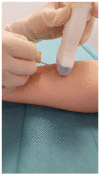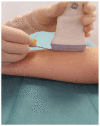Ultrasound guided cannulation of dialysis access
- PMID: 34590502
- PMCID: PMC8606623
- DOI: 10.1177/11297298211047328
Ultrasound guided cannulation of dialysis access
Abstract
Vascular access is the key part of haemodialysis (HD) treatment, as this is not possible without a functioning access. The use of the arteriovenous fistula (AVF) has fewer complications, lower mortality and fewer hospital admissions compared to central venous catheter (CVC). However, although guidelines recommend AVF as the access of choice, access-related cannulation complications may lead to greater morbidity. Most guidelines recommend using Doppler ultrasound (DU) to surveil the AVF for HD, but its use must not only be limited to surveillance as it can also be used for needling. Therefore, among those techniques at our disposal today, one of the best tools for AVF needling is Doppler ultrasound (DU). Despite the lack of evidence regarding ultrasound-guided needling of AVF, it is becoming part of our usual practice arsenal in many HD centres. Its use has allowed needling results to improve and the number of complications to be reduced versus traditional 'blind' needling. It should be remembered that even though it is very useful for the daily work of dialysis nurses, as in the case of other techniques, it requires adequate, specialised and long-term training to acquire competence in using it. For example, it is important to learn some concepts and terminology that should be known and, at the same time, be highly familiar with different techniques available. Two types of needling techniques are described using US assistance: US-guided needling, where DU is used to make a map of the vessels which can be utilised and to mark the best site to insert the needles once the mapping is done; and real-time US-guided needling, the simultaneous manipulation of the probe and the insertion of the puncture needle through the slice plane of the ultrasound device. Regarding the real-time technique, there are two approaches: out of plane (the probe takes a transversal image of the needle) and in plane (vessel axis aligned with the probe and the needle in the same plane) To ensure successful needling and to maximise reproducibility, especially with tight deadlines and staff resources, nursing staff need to follow some important recommendations that include safety and the use of the method, both for them and the patient. In this way, ultrasound-guided needling becomes a tool with enormous potential utility, but practical training is as important as knowing the technique.
Keywords: AV fistula; Cannulation; dialysis access; prosthetic grafts; techniques and procedures; ultrasonography – Doppler evaluation.
Conflict of interest statement
Figures
References
-
- ERA-EDTA Registry. Annual report 2017, Amsterdam UMC, location AMC, Department of Medical Informatics, Amsterdam, the Netherlands, 2019, https://era-edta-reg.org/files/annualreports/AnnRep2017.pdf (accessed 14 July 2021).
-
- Perl J, Nessim SJ, Moist LM, et al.. Vascular access type and patient and technique survival in home hemodialysis patients: the Canadian organ replacement register. Am J Kidney Dis 2016; 67(2): 251–259. - PubMed
MeSH terms
LinkOut - more resources
Full Text Sources
Medical








